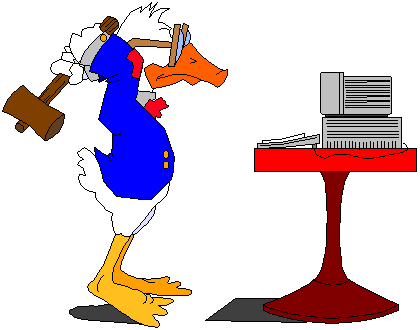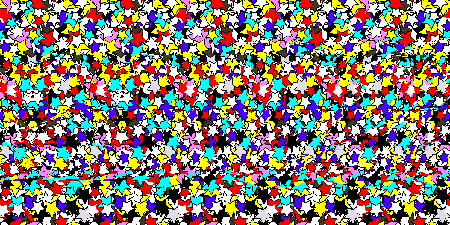

Just relax, this is a common and frustrating problem. But, thankfully there are a few great techniques to help you in learning how to view stereograms.
First read up on why certain people can't see stereograms, then as long as you don't fit into one of those rare cases you CAN see these images. If the images you see are distorted, inverted, or just plain wierd (but still three dimensional), then you almost have it. Regardless, all you need is a little patience, and a few of these techniques. Try them on the simple stereogram below.

Most Stereogram pictures are usually generated so that if you look at (converge your eyes on) a position twice as far away as the picture, and focus on the picture, generally after a few minutes you see a surprising 3D image!
Most people find this extremely difficult for the first time. You have to focus on a point different from where you are looking. This is known as "de-coupling" your vision process. Instinctively people focus at the same point they are looking at, and this is the main obstacle in seeing images of this type.
This is why most posters come with a reflective surface such as a glass sheet or plastic covering them---if you try to look at your reflection on the image, you will be looking at a point twice as far away as the actual poster. It is noted by almost everyone, that while this sometimes helps beginners see the 3D effect for the first (and perhaps even the first few) times, experienced viewers do not need any help like this. Indeed the reflection is usually very distracting and decreases the quality of the 3D effect to an experienced viewer.
There are many ways to teach this de-coupling to either yourself or to others, including (in almost no particular order):
NOTE: It is generally easier to see Stereograms under bright light. This is because you eye relies less on focus under harsh conditions. Also, in order to see stereo images, you need to have "passable" use of both eyes. (See the above section on why certain people can't see stereograms). If you wear glasses try with and without them on. Some short-sighted people can see the images easier without their glasses on (if they get closer to the picture).
Hold the picture (or move your face) so your nose is touching the picture. Most people cannot possibly focus with something this close to their eyes, and they will be content with their inability to focus. With the picture up close, pretend that you are looking straight ahead, right through it. Now slowly pull the picture (or your face) away while keeping your eyes pointed straight ahead. If you do this slow enough, an image usually appears when the picture is at the correct distance.
As mentioned above, with a reflective surface it is sometimes a lot easier to converge your eyes in the correct position. You simply focus on your nose or some central reflection in the picture, and wait until you focus on the image.
Hold the picture so that it is half between you and a wall. Look *over* the top of the picture towards the wall, and focus on something such as a picture hook or mark. While keeping this "gaze" either slowly lift the picture or lower your eyes while keeping them converged on the wall. A similar approach (but for cross-eyed viewing) is to stand arm's length away from the picture and put your finger on the picture. While slowly pulling your finger towards your face, keep looking at your finger, you will notice the picture becoming blurry, and at an intermediate position you will (eventually) see the 3D image.
Photocopy the picture onto a transparency. Then focus through the transparency onto something twice as far away. This is similar to (The wall, or the finger) above except now you don't need to change the position of your gaze.
To cheat, photocopy the image onto two transparencies, then overlay them and carefully shift them horizontally so they are about an inch or two out of alignment. Somewhere around this position you will see a rendition of the image. This image is obviously in 2D not 3D, but you will at last finally believe there is "something in there."
Distorted, inverted, or just plain weird:
So you almost see something? The image you see is three dimensional, but maybe it's distorted, or inverted, with mountains looking like valleys and vica versa. Take heart, you're almost there!
If you see mountains where you should see valleys, then you are focussing in front of the screen rather than behind. This reverses the entire effect and objects that are supposed to look close really look far away. Congratulations, you managed to hit the second foci. This is usually much harder to focus on. Try again, this time looking behind the paper instead of in front of the image.
If you see distorted and bubbly images, then you are looking too far behind the image. The stereogram is sometimes made up of multiple copies of the same seeming random pattern. If you are bringing into focus copies of the pattern that are not adjacent (that are farther apart), you will see a strange pattern. You need to concentrate on focusing closer to the picture.
Why certain people can't see stereograms:
The basic principle behind a stereogram depends on the ability for a person to merge multiple objects into one. There are many factors that could inhibit a person's ability to see the object hidden beneath the initial surface. As an example... place your thumbs and index fingers together in the shape of a triangle, and find an object in the distance to look at through the triangle. It must be a distant object! Independently close one eye, then the other... you will notice that you were able to see the complete object through one eye without moving the triangle. This concept is called eye dominance. Sometimes the brain will shut off one eye, and rely on the dominant eye, if the object to be viewed doesn't come in focus. There are many people who need corrected vision that don't realize it because of the human ability to adapt.
Another possible cause is convergence. At close range (12-18 inches), your eyes converge an average of 3mm...but this is not so for everyone. Just as you have a dominant eye for distance, you will also have a dominant eye for near. After years of depending on one eye to do the majority of the work, you can depend less on convergence and adaptability. By allowing your eyes to relax, and blur....you attempt to overide your brain's intent, and allow both eyes to be equally dysfunctional. Thus, images begin to overlap and the muscles that control your eyes are less likely to fix at the same point that they normally would. The same people that have problems crossing their eyes...even a little...will have the greatest frustration when attempting to view stereograms.
Other conditions such as esophoria and esotropia can cause the eye to move inwards...(commonly called a lazy eye), and exophoria and exotropia (a tendency nfor an eye to shift toward the temple), will have an impact. I would suggest that people could adjust their distance from the stereogram and have a greater rate of success. A distance that works for the majority, doesn't always work for everyone. And last but not least...I would enjoy the statistics relating the ability of person to see stereograms with regard to their profession. Analytical/Artistic mindset?
If you fit into one of these categories, then you are in the lucky few. You actually have an excuse for not being able to see the image. Otherwise, buck up and try a few different methods of seeing stereograms.
Note***
"Richards (1970; Experimental Brain Research 10, 380-388) did a survey among 150 MIT students and noticed that "...about 4% of the students are unable to use the cue offered by disparity, and another 10% have great difficulty and incorrectly report the depth of a Julesz figure <stereogram> relative to background." He further concludes that inability to use stereopsis is an inherited defect and is related to "three-pool"-hypothesis of binocular neurons."
|
| ||
BACK |
|
NEXT |